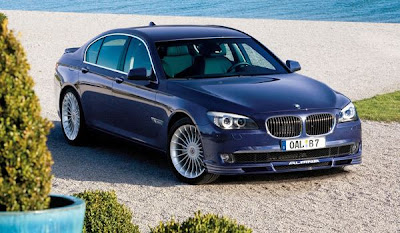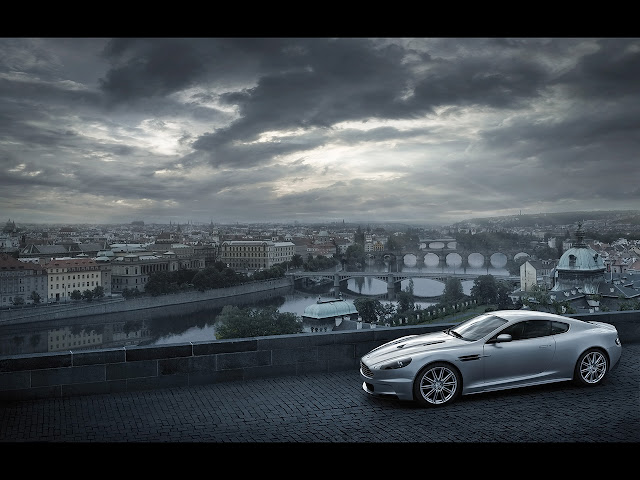2011 BMW Alpina B7
In today's consolidated and homogenized global auto industry, Alpina is an odd duck. Based in the southern German town of Buchloe, not far from Munich, the company started taking form back in 1961, when a German entrepreneur called Burkard Bovenspielen began to diversify the family typewriter company into an activity he was more passionate about—making high-performance automobile components. By the late 1980s, the company had focused on its current business: modifying BMWs (BMW:GR) to improve their performance and reselling them through BMW dealers. Mercedes' AMG division has similar roots, the difference being that founder Hans-Werner Aufrecht sold AMG to Mercedes in the 1990s, while Alpina remained independent.
I recently test-drove the 2011 BMW Alpina B7, which hit dealerships in May and is the only Alpina model sold in the U.S. It's quite a car. If you've ever wondered why there's no high-performance "M" version of the 7 Series, as there is of most other BMW models, it may be because of Alpina. The B7 lineup consists of extensively retooled and upgraded versions of the BMW 750i, the long-wheel-base 750Li, and the all-wheel-drive versions of those vehicles. Alpinas are not only quicker and sportier but offer smoother riding than the equivalent BMW production models. They're also among the most exclusive cars on the market: Alpina expects to sell only around 1,000 B7s annually, about 400 of them in the U.S.
Alpina makes extensive mechanical modifications to the 7 Series. For starters, BMW's 4.4-liter V8 engine is significantly tweaked, with enlarged turbos, high-performance pistons, reinforced cylinder heads, and other modifications that raise horsepower to 500 and torque to 516 ft./lbs. (up from 400 hp. and 450 ft./lbs. of torque for the BMW 750i). Cooling capacity is dramatically expanded, the engine fan is enlarged and the rear differential has a shell made of cast iron, rather than aluminum, to improve heat transfer. Enlarged brakes are added, as are big, beautiful 21-in. spoked wheels clad with Michelin performance tires. Special front and rear spoilers and a new front fascia are added, too.
The car's springs are stiffened and the chassis lowered a fraction of an inch closer to the road. BMW's electronic suspension system is reconfigured to emphasize the difference between the "comfort," "normal," and "sport" settings. BMW's six-speed automatic transmission is beefed up and sport-tuned via Alpina's proprietary shift controls.
In width, length, interior space, and luggage capacity, the B7 is comparable to an equivalent BMW (which is to say the B7 is roomy and has a 14-cu.-ft. trunk). The classic paint job is a metallic Alpina blue, but the B7 is also offered in all the colors the 7 Series comes in.
The Alpina comes with all of a BMW's standard safety gear, including a full complement of air bags and stability and traction control. Fuel economy is similar, too. The B7 is rated to get 15 miles-per-gallon in the city and 21 on the highway. (City mileage drops to 14 with all-wheel drive.) That's about the same as the 2011 BMW 750i, which is rated at 15/22 with rear-wheel drive, and 14/20 with all-wheel drive.
Not surprisingly, however, an Alpina is considerably pricier than a comparable BMW. The B7 starts out at about $124,000, including destination and gas-guzzler taxes—about $40,000 more than a 2011 BMW 750i. Add $3,000 to the B7's price for all-wheel drive and $3,900 for a long wheel base. However, the B7 comes packed with around $14,000 worth of standard equipment that is optional on a comparable BMW (heads-up display, premium sound system, full leather interior, and so forth), reducing the real price premium.
Alpina makes extensive mechanical modifications to the 7 Series. For starters, BMW's 4.4-liter V8 engine is significantly tweaked, with enlarged turbos, high-performance pistons, reinforced cylinder heads, and other modifications that raise horsepower to 500 and torque to 516 ft./lbs. (up from 400 hp. and 450 ft./lbs. of torque for the BMW 750i). Cooling capacity is dramatically expanded, the engine fan is enlarged and the rear differential has a shell made of cast iron, rather than aluminum, to improve heat transfer. Enlarged brakes are added, as are big, beautiful 21-in. spoked wheels clad with Michelin performance tires. Special front and rear spoilers and a new front fascia are added, too.
The car's springs are stiffened and the chassis lowered a fraction of an inch closer to the road. BMW's electronic suspension system is reconfigured to emphasize the difference between the "comfort," "normal," and "sport" settings. BMW's six-speed automatic transmission is beefed up and sport-tuned via Alpina's proprietary shift controls.
In width, length, interior space, and luggage capacity, the B7 is comparable to an equivalent BMW (which is to say the B7 is roomy and has a 14-cu.-ft. trunk). The classic paint job is a metallic Alpina blue, but the B7 is also offered in all the colors the 7 Series comes in.
The Alpina comes with all of a BMW's standard safety gear, including a full complement of air bags and stability and traction control. Fuel economy is similar, too. The B7 is rated to get 15 miles-per-gallon in the city and 21 on the highway. (City mileage drops to 14 with all-wheel drive.) That's about the same as the 2011 BMW 750i, which is rated at 15/22 with rear-wheel drive, and 14/20 with all-wheel drive.
Not surprisingly, however, an Alpina is considerably pricier than a comparable BMW. The B7 starts out at about $124,000, including destination and gas-guzzler taxes—about $40,000 more than a 2011 BMW 750i. Add $3,000 to the B7's price for all-wheel drive and $3,900 for a long wheel base. However, the B7 comes packed with around $14,000 worth of standard equipment that is optional on a comparable BMW (heads-up display, premium sound system, full leather interior, and so forth), reducing the real price premium.


Comments
Post a Comment